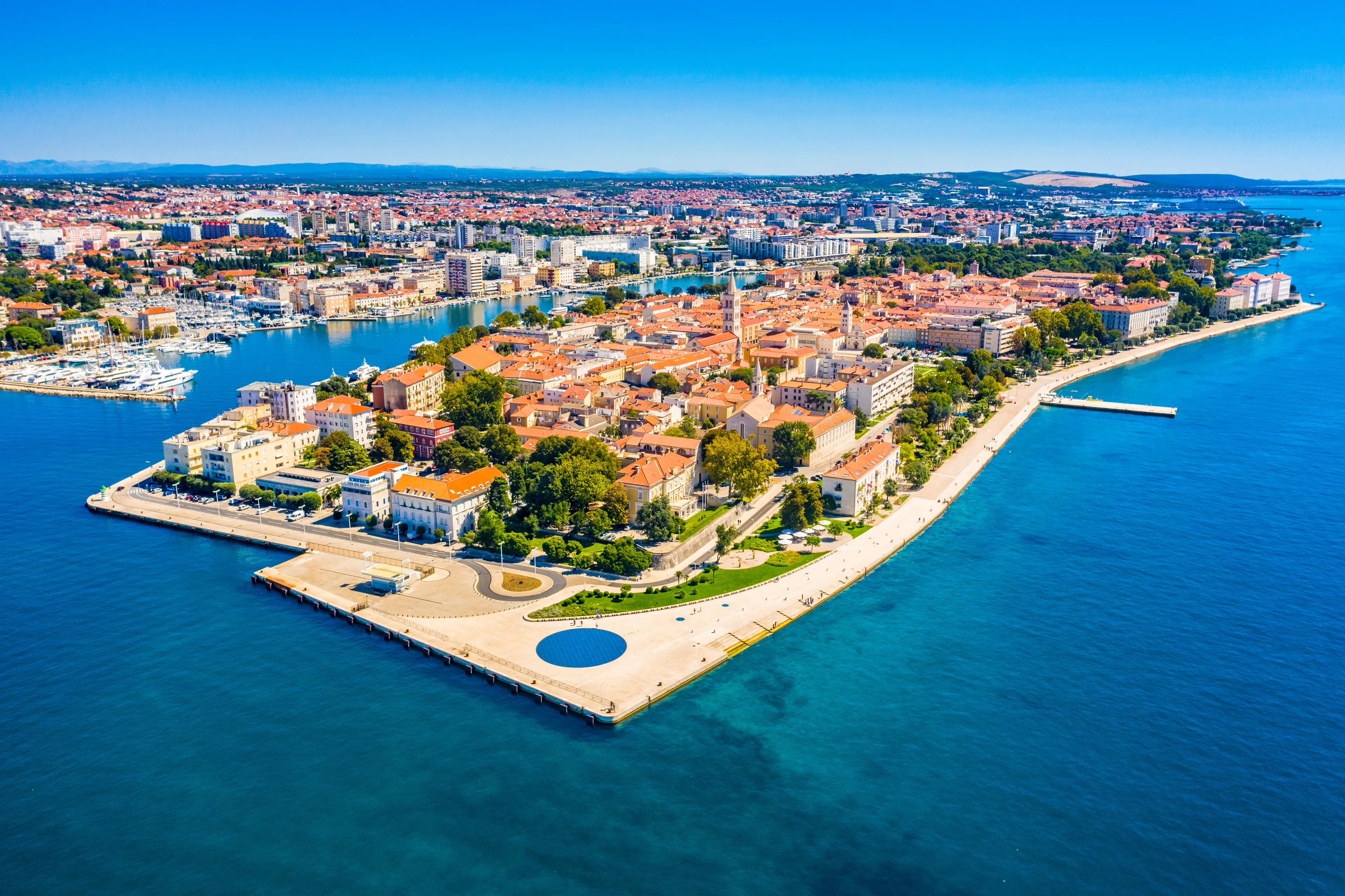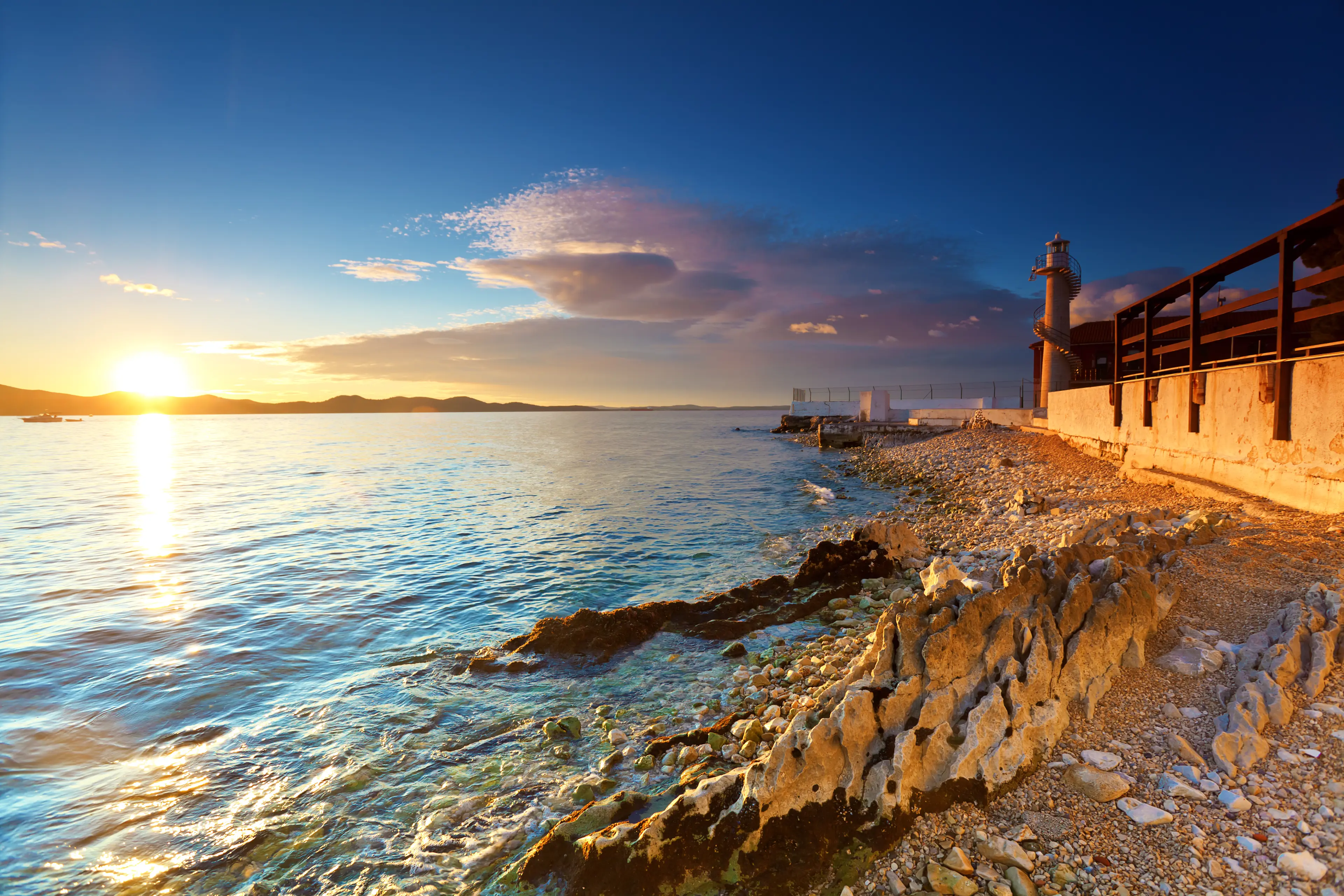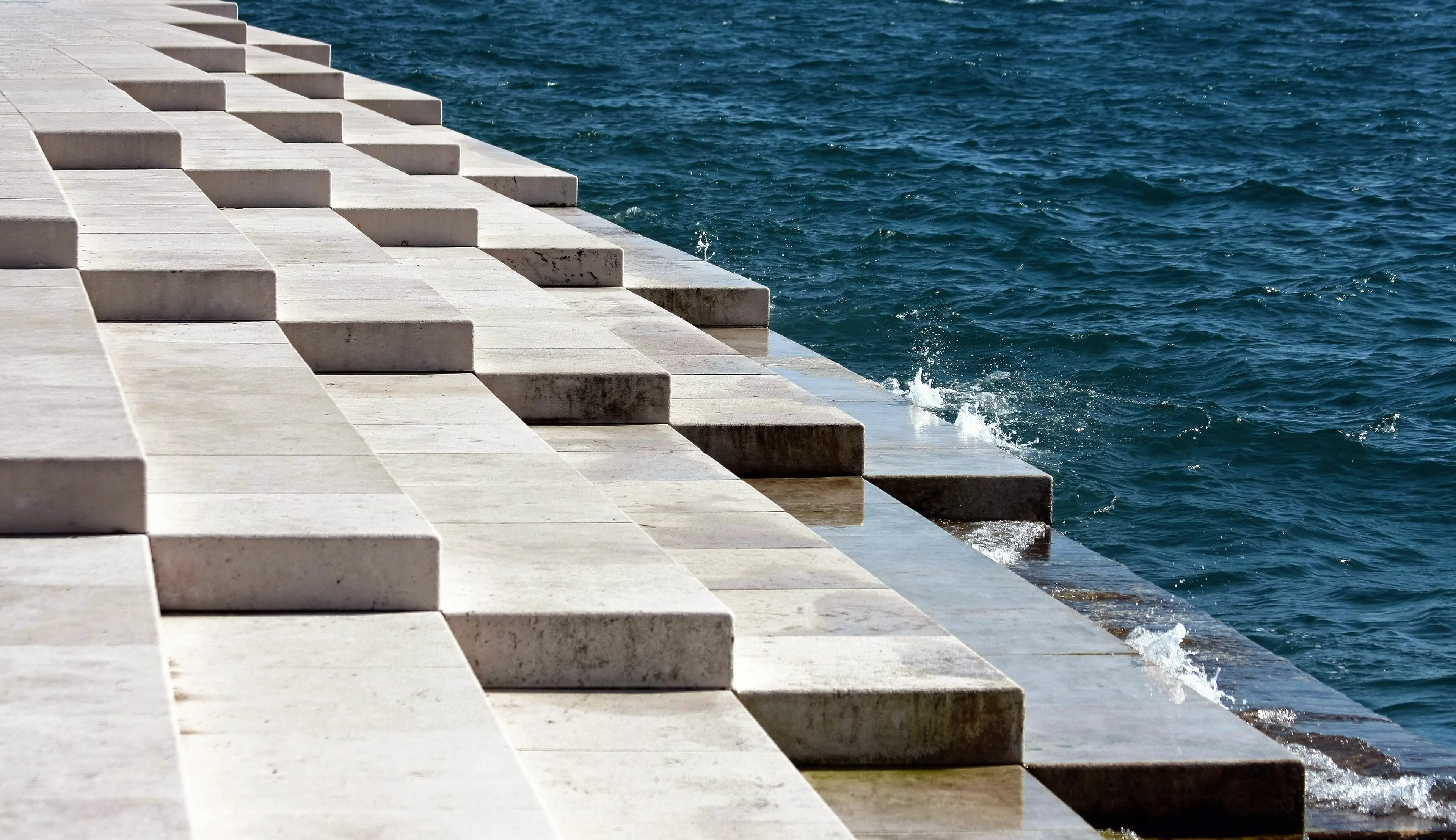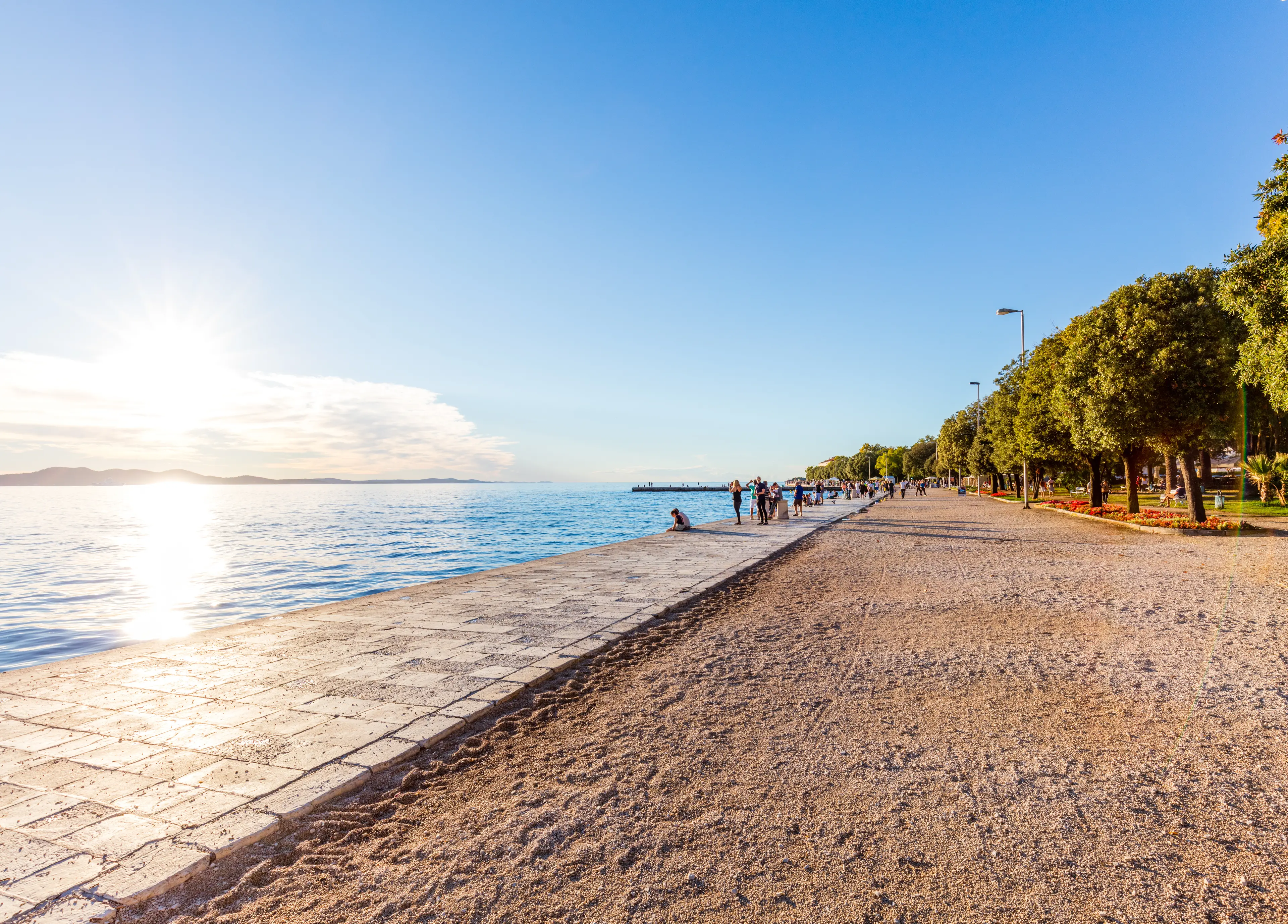1-Day Local Experience: Solo Outdoor Adventures in Zadar, Croatia
Zadar, Croatia
1 days





About Zadar, Croatia
Discover the captivating charm of Zadar, Croatia, a city rich in history and culture. Nestled on the Dalmatian Coast, Zadar offers a unique blend of ancient Roman ruins, medieval churches, and modern attractions. Visit the Sea Organ, a unique architectural marvel that creates music from the waves, or the Sun Salutation, an interactive light display. Explore the city's old town, filled with cobblestone streets, quaint cafes, and the stunning St. Donatus Church. Take a ferry to the nearby Kornati National Park, a cluster of islands offering pristine beaches and crystal-clear waters. Whether you're a history buff, a nature lover, or a foodie, Zadar has something to offer. Experience the magic of Croatia in Zadar.
1-Day Itinerary
Attractions in Itinerary (4)

1Riva Promenade
Riva Promenade is a lively seafront promenade filled with cafes, restaurants, and shops. It offers stunning views of the sea and nearby islands. It's a great place for a leisurely stroll, people watching, or enjoying a meal or drink while watching the sunset.

2Sea Organ
An experimental musical instrument which plays music by way of sea waves and tubes located underneath a set of large marble steps.

3Greeting to the Sun
A monument to the sun which consists of 300 multi-layered glass plates placed on the same level with the stone-paved waterfront in the shape of a 22-meter diameter circle.

4Roman Forum
The social, economic and religious center during the Roman times, offering a glimpse into the ancient history of Zadar.
Local Food and Drinks (12)

Peka
A traditional Croatian dish that is usually prepared with octopus, lamb, veal, or chicken, along with potatoes and other vegetables. It's cooked under a bell-like dome, or 'ispod čripnje'. This method of slow cooking gives the dish a unique flavor that is a must-try when in Zadar.

Paški sir
A hard, sheep's milk cheese from the island of Pag. It's known for its distinct flavor due to the island's unique vegetation, which the sheep feed on. It's a popular part of the local cuisine in Zadar.

Maraschino
A distinctive cherry liqueur that originated in Zadar. It's made from the Marasca cherry, a variety native to the Dalmatian coast. The liqueur has a unique, slightly bitter taste and is often served as a digestif.

Crni rižot
A black risotto made with cuttlefish or squid, rice, garlic, red wine, and olive oil. The ink from the cuttlefish or squid gives the dish its black color and a rich, briny flavor. It's a common dish in Zadar and along the Dalmatian coast.

Pršut
A dry-cured ham similar to Italian prosciutto. It's typically served thinly sliced as an appetizer or part of a charcuterie board. Pršut is a staple in Zadar and throughout Croatia.

Brudet
A fish stew made with several types of fish and shellfish, tomatoes, onions, and a variety of herbs and spices. It's a traditional dish in Zadar and along the Adriatic coast.

Rakija
A strong fruit brandy that is popular in Croatia. It's made from a variety of fruits, including plums, grapes, and apricots. Rakija is often served as an aperitif in Zadar.

Rožata
A traditional Croatian custard pudding similar to flan. It's made with eggs, sugar, milk, and a local liqueur called rosin, which gives it a unique flavor. Rožata is a popular dessert in Zadar.

Skuta
A fresh cheese similar to ricotta. It's often served with salads, pastries, or as a dessert with honey. Skuta is a common part of the local cuisine in Zadar.

Kroštule
A traditional Croatian dessert made from dough that is deep-fried and sprinkled with powdered sugar. Kroštule is a popular treat in Zadar, especially during the Carnival season.

Bobići
A traditional Croatian dish made with corn, potatoes, and various vegetables. It's a hearty and comforting dish that is often enjoyed in Zadar.

Ožujsko
A popular Croatian beer that is often enjoyed in Zadar. It's a light lager with a crisp, refreshing taste.
Best time to visit
The best time to visit Zadar, Croatia is from late May to early September. During this period, the weather is warm and sunny, perfect for exploring the city's historical sites, enjoying the beautiful beaches, and participating in outdoor activities. However, if you prefer fewer crowds, the shoulder seasons of April-May and September-October are also great times to visit, with pleasant weather and slightly cooler temperatures.
How to get around
Walk
Zadar is a compact city, making it easy to explore on foot. Most attractions, including the Sea Organ and the Greeting to the Sun, are within walking distance from each other.
Bicycle
Zadar is a bike-friendly city with numerous bike paths and rental shops. It's a great way to explore the city and its surroundings at your own pace.
Public Bus
Zadar's public bus system is reliable and covers most of the city and surrounding areas. It's a cost-effective way to get around, especially for longer distances.
Taxi
Taxis are readily available in Zadar. They can be hailed on the street, booked via phone, or picked up from designated taxi stands. It's a convenient but more expensive option.
Ridesharing
Uber is available in Zadar, offering a convenient and often cheaper alternative to traditional taxis. You can book a ride using the Uber app on your smartphone.
Car Rental
Renting a car can be a good option if you plan to explore outside of Zadar. However, keep in mind that parking in the city center can be challenging.
Ferry
Zadar is a coastal city with numerous islands nearby. Ferries and catamarans operate regular services to these islands, offering a unique way to explore the region.
Tourist Train
A tourist train operates in Zadar, offering a fun and convenient way to see the city's main sights. It's especially popular with families and those with limited mobility.
Important information
Currency€ EUR
Time zoneUTC+1
Driving sideRight
Emergency phone112
Drinking waterYes
Power sockets
Voltage230 V
Things to know about Zadar, Croatia as a first time visitor
1
Zadar is a coastal city in Croatia, located on the Adriatic Sea.
2
The official language is Croatian, but English is widely spoken, especially among the younger generation and in tourist areas.
3
The local currency is the Croatian Kuna (HRK). Credit cards are widely accepted, but it's a good idea to carry some cash for smaller establishments.
4
Zadar has a Mediterranean climate, with hot, dry summers and mild, wet winters. Average summer temperatures range from 70°F to 90°F (21°C to 32°C), while winter temperatures range from 40°F to 55°F (4°C to 13°C).
5
Tipping is customary in Croatia. It's common to leave a 10-15% tip in restaurants and cafes.
6
Zadar is known for its seafood. Be sure to try local specialties like black risotto, made with squid ink, and buzara, a shellfish stew.
7
Public transportation in Zadar is reliable and affordable. The city has a good network of buses, and taxis are also readily available.
8
Zadar is a safe city, but like any tourist destination, it's important to be aware of your surroundings and keep an eye on your belongings.
9
Croatia is a member of the European Union, but it is not part of the Schengen Area. This means you may need a visa to visit, depending on your nationality.
10
Zadar has a rich history, with Roman, Byzantine, and Venetian influences. It's worth taking a guided tour to learn more about the city's past.
11
The city is pedestrian-friendly, with many of the main attractions located within walking distance of each other.
12
Zadar is known for its stunning sunsets. The best place to watch the sunset is from the Sea Organ, an art installation that plays music powered by the waves.
13
Croatia uses the Type C and Type F plug sockets. The standard voltage is 230 V, and the standard frequency is 50 Hz.
14
Tap water is safe to drink in Zadar, but bottled water is also readily available.
15
Zadar is a great base for exploring the surrounding region, including the Kornati Islands and Plitvice Lakes National Park.
16
The city has a range of accommodation options, from luxury hotels to budget hostels and vacation rentals.
17
Zadar has a vibrant nightlife, with many bars and clubs located in the Old Town.
18
The city hosts numerous festivals and events throughout the year, including the Zadar Summer Theatre Festival and the Full Moon Festival.
19
Shopping in Zadar offers a mix of high-end boutiques, local artisan shops, and markets. The city is known for its handmade lace and maraschino liqueur.
20
Emergency numbers in Croatia are 112 for general emergencies, 194 for medical emergencies, and 192 for the police.
Basic Croatian to know as a first time visitor
English phrase | Native phrase | Pronunciation | When to use it |
|---|---|---|---|
Hello | Bok | bohk | Greeting someone |
Goodbye | Doviđenja | doh-vee-jen-ya | Leaving or saying goodbye |
Please | Molim | moh-leem | Asking for something |
Thank you | Hvala | hva-la | Showing appreciation |
Yes | Da | dah | Agreeing or confirming |
No | Ne | neh | Disagreeing or denying |
Excuse me | Oprostite | oh-pro-stee-teh | Getting attention or apologizing |
I don't understand | Ne razumijem | neh rah-zoo-me-yem | When you don't understand something |
Do you speak English? | Govorite li engleski? | goh-voh-ree-teh lee eng-les-kee? | To ask if someone speaks English |
Where is the bathroom? | Gdje je kupaonica? | gd-yeh yeh koo-pah-oh-neet-sah? | To ask for the bathroom location |
I need a doctor | Trebam liječnika | treh-bam lee-yeh-chnee-kah | In case of medical emergency |
Help | Pomoć | poh-mohch | In case of emergency |
How much does it cost? | Koliko to košta? | ko-lee-ko toh kosh-tah? | To ask for the price |
I would like to order | Želim naručiti | zheh-leem nah-roo-chee-tee | Ordering food or drink |
Water | Voda | voh-dah | Ordering water |
Beer | Pivo | pee-voh | Ordering beer |
Wine | Vino | vee-noh | Ordering wine |
Cheers | Živjeli | zhee-vye-lee | Toasting |
Good morning | Dobro jutro | doh-broh yoo-troh | Morning greeting |
Good night | Laku noć | lah-koo notch | Saying goodnight |
Packing List
Clothing
Comfortable walking shoes
Lightweight clothing
Swimwear
Sunglasses
Hat
Light jacket or sweater for the evening
Toiletries
Travel-size toothpaste
Toothbrush
Travel-size shampoo and conditioner
Deodorant
Razor
Sunscreen
Lip balm with SPF
Hand sanitizer
Travel documents and essentials
Passport/ID
Wallet with credit/debit cards and cash
Travel insurance documents
Hotel reservation details
Map of Zadar
Electronics and gadgets
Smartphone
Charger for smartphone
Camera
Charger for camera
Power bank
Headphones
Miscellaneous items
Reusable water bottle
Snacks
Travel guidebook for Zadar
Backpack or daypack
Travel pillow
First-aid kit
Weather Conditions
When planning a visit to Zadar, Croatia, it's important to consider the weather as it can greatly influence your travel experience. Zadar experiences a Mediterranean climate, which means warm, dry summers and mild, wet winters. If you're a sun-seeker, the best time to visit Zadar is from June to September when the weather is typically sunny and warm. During these months, the average high temperatures range from 80°F to 90°F (27°C to 32°C), perfect for beach activities and exploring the city's outdoor attractions. However, this is also the peak tourist season, so expect larger crowds and higher prices. For those who prefer cooler temperatures and fewer crowds, consider visiting in the shoulder seasons of April-May and October-November. During these periods, the weather is generally mild with average high temperatures ranging from 60°F to 75°F (16°C to 24°C). This is a great time for sightseeing and outdoor activities like hiking and cycling. If you plan to visit during the winter months from December to February, be prepared for cooler and wetter conditions. Average high temperatures during this time range from 50°F to 55°F (10°C to 13°C), and there can be occasional rainfall. However, this is also a great time to enjoy Zadar's indoor attractions, such as its museums and churches, without the crowds. Regardless of when you visit, it's always a good idea to pack layers to accommodate for changing weather conditions. Also, don't forget to pack sun protection, such as a hat, sunglasses, and sunscreen, especially if you're visiting in the summer months. Lastly, keep an eye on the local weather forecast during your trip to help plan your activities and ensure a comfortable and enjoyable visit to Zadar.
| Month | Hi / Lo (°C) | Weather Overview |
|---|---|---|
January | 12° / 2° | January is the coldest month in Zadar, with temperatures ranging from 2°C to 12°C. It's a quiet time to visit, but pack warm clothes. |
February | 13° / 3° | February is still chilly with temperatures slightly higher than January. It's a good time to visit if you prefer less crowded places. |
March | 16° / 6° | March sees the start of spring with temperatures ranging from 6°C to 16°C. The weather is mild, making it a good time for sightseeing. |
April | 19° / 9° | April is a pleasant month with temperatures ranging from 9°C to 19°C. It's a great time to enjoy outdoor activities. |
May | 23° / 13° | May offers warm temperatures ranging from 13°C to 23°C. It's an excellent time to visit the beaches and enjoy water sports. |
June | 26° / 16° | June marks the start of summer with temperatures ranging from 16°C to 26°C. It's the perfect time for sunbathing and swimming. |
July | 29° / 19° | July is the hottest month in Zadar with temperatures ranging from 19°C to 29°C. It's the peak tourist season, so expect crowded places. |
August | 29° / 19° | August is equally hot as July with temperatures ranging from 19°C to 29°C. It's a great time to enjoy the vibrant nightlife of Zadar. |
September | 25° / 15° | September offers pleasant weather with temperatures ranging from 15°C to 25°C. It's a good time to visit for those who prefer less crowded places. |
October | 21° / 11° | October sees the start of autumn with temperatures ranging from 11°C to 21°C. It's a good time to enjoy the fall colors in Zadar. |
November | 17° / 7° | November is a bit chilly with temperatures ranging from 7°C to 17°C. It's a quiet time to visit, but pack warm clothes. |
December | 13° / 3° | December is the start of winter with temperatures ranging from 3°C to 13°C. It's a festive time to visit with Christmas markets and celebrations. |
Did you know?
Places near by Zadar, Croatia

Plitvice Lakes National Park
A UNESCO World Heritage site, known for its cascading lakes and waterfalls.

Krka National Park
Famous for its stunning waterfalls and natural pools.

Split
A vibrant city known for its beaches and the fortresslike complex at its center, Diocletian's Palace.

Paklenica National Park
Known for its two stunning canyons, Mala and Velika Paklenica.

Kornati National Park
A nautical paradise, comprising 89 unforgettable islands, islets and reefs.

Sibenik
A historic city in Croatia, known for its fortress and the Cathedral of St. James.

Pag Island
Famous for its moon-like landscape, cheese, and lace-making tradition.

Trogir
A historic town and harbour on the Adriatic coast, known for its preserved old town, encircled by medieval walls.

Rovinj
A Croatian fishing port on the west coast of the Istrian peninsula, known for its old town and the hilltop church of St. Euphemia.

Zagreb
The capital city of Croatia, known for its 18th- and 19th-century Austro-Hungarian architecture.